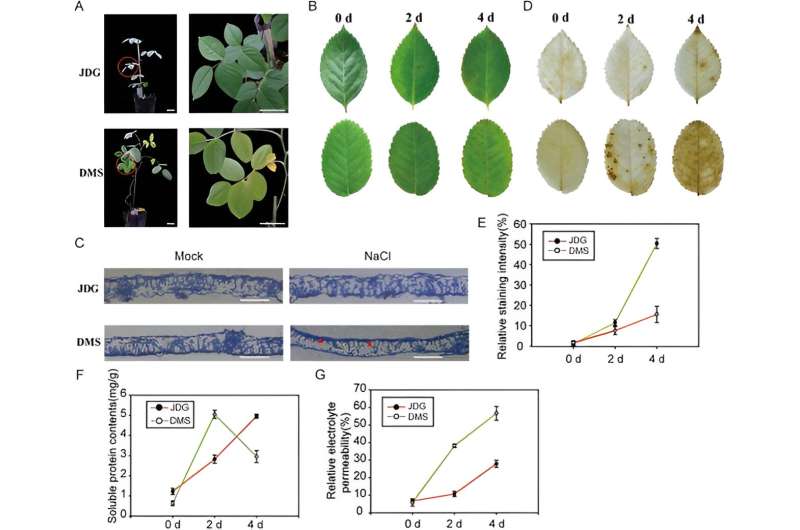This article has been reviewed according to Science X's editorial process and policies. Editors have highlighted the following attributes while ensuring the content's credibility:
fact-checked
peer-reviewed publication
trusted source
proofread
Blooming through adversity: Roses' genetic defense against salinity stress

A cutting-edge study illuminates the intricate mechanisms of rose plants' resistance to salt stress, a critical issue for global agriculture. The research identifies the phenylpropane pathway, especially flavonoids, as key to this tolerance, offering insights into potential genetic modifications for crops to thrive in saline conditions.
Salinity stress poses a significant challenge to crop production worldwide, particularly in rose cultivation. Salt stress can severely inhibit plant growth, reduce flower quality, and cause economic losses.
Roses are valued not only for their ornamental appeal but also for their bioactive substances used in cosmetics and medicine. Due to these challenges, there is a need to explore the mechanisms of salt tolerance in roses to enhance their resilience and economic potential. Based on these challenges, there is a need to conduct in-depth research on the mechanisms of salt tolerance in roses.
A team from China Agricultural University, in collaboration with the Yunnan Academy of Agricultural Sciences and LVMH Recherche, conducted a comprehensive multi-omics study on the salt tolerance of two rose cultivars, Rosa hybrida cv. Jardin de Granville (JDG) and Rosa damascena Mill. (DMS).
The research, published in Horticulture Research investigates the metabolic and molecular responses of these cultivars to salt stress. The study highlights the importance of the phenylpropane and flavonoid pathways in enhancing salinity tolerance, offering new perspectives on developing salt-resistant rose varieties.
The study treated JDG and DMS rose plants with 400 mM NaCl for two weeks to examine their salt stress responses. JDG showed greater tolerance, with only slight wilting, while DMS exhibited severe leaf damage.
Metabolome profiling revealed significant changes in phenolic acid, lipid, and flavonoid metabolite levels under salt stress in both cultivars. Proteome analysis identified enrichment of flavone and flavonol pathways in JDG, and RNA sequencing indicated that salt stress influenced primary metabolism in DMS and secondary metabolism in JDG.
The integration of these datasets highlighted that the phenylpropane pathway, especially the flavonoid pathway, is strongly enhanced under salt stress.
The study also identified chalcone synthase 1 (CHS1) and the transcription factor bHLH74, which inhibits CHS1 expression, as key components in flavonoid biosynthesis. These findings suggest that flavonoid metabolism is crucial for JDG's salt tolerance, providing a biochemical basis for its resilience.
Dr. Xiaofeng Zhou, the corresponding author, said, "Our research provides a comprehensive understanding of the metabolic and molecular mechanisms underlying salt tolerance in roses. By identifying key pathways and regulatory genes, we can develop new strategies to breed salt-tolerant rose varieties, ensuring better growth and productivity in saline environments."
The findings from this study have significant implications for the horticultural industry, particularly in regions affected by soil salinization.
By enhancing the understanding of the metabolic pathways involved in salt tolerance, breeders can develop new rose varieties that are more resilient to salinity stress. This not only ensures better plant growth and flower quality but also enhances the economic value of roses in the cosmetics and medicinal industries, where bioactive compounds play a crucial role.
More information: Haoran Ren et al, Multi-omics analysis reveals key regulatory defense pathways and genes involved in salt tolerance of rose plants, Horticulture Research (2024). DOI: 10.1093/hr/uhae068
Journal information: Horticulture Research
Provided by NanJing Agricultural University





















